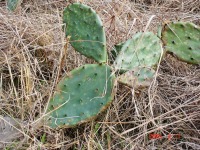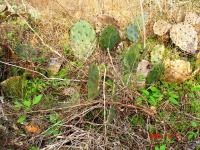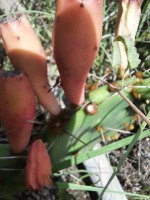
Mackensen, Bulletin of the Torrey Botanical Club 38: 141, 1911
Holotype; Isotype; Isotype; Herbarium; Herbarium; Herbarium; Herbarium; Herbarium; Herbarium; Painting (Britton and Rose, v1 1919, plate XXVIII, No. 1 and 2, left); Photograph
Original Description
What is Opuntia leptocarpa?
Opuntia leptocarpa is a pricklypear cactus that grows in east-central and central Texas, and areas extending from there. It grows with O. macrorhiza, O. lindheimeri, and other smaller Opuntias. Plants are not numerous in most locations.
Details
Stems are ascending, typically less than 30(50) cm. Pads are thin, oval, obovate, or elliptic, 10 to 20(25) cm long. Spines may be tan (or cream-yellow), darkening to brown or red-brown at the base, 20-30 mm long. Older cladodes may lack spines altogether. Areoles have reddish glochids and white wool when young. Upper areoles may have 3-5 whitish, light brown, or mottled spines 1-3 cm long. Plants may have enlarged roots.
Flower buds are thin and have rust-colored glochids. Anthers are yellow, and filaments are yellow-white or white. The stigmas are pale white, yellow, or green. Tepals are gold-yellow or canary yellow. Inner tepals typically have at least a small amount of reddish pigment at their bases. As the name implies, the pericarp and the fruit may be long and slender with a stipitate-like base.
Ploidy is unknown.
Other Notes
Some botanists suggest this taxon is the same as O. pyrocarpa, but we have observed it forms smaller plants with more slender flower buds. Britton and Rose (p. 166) described O. leptocarpa as a possible hybrid of O. macrorhiza and O. lindheimeri, which seems unlikely.






















Where in Alabama is this species found?